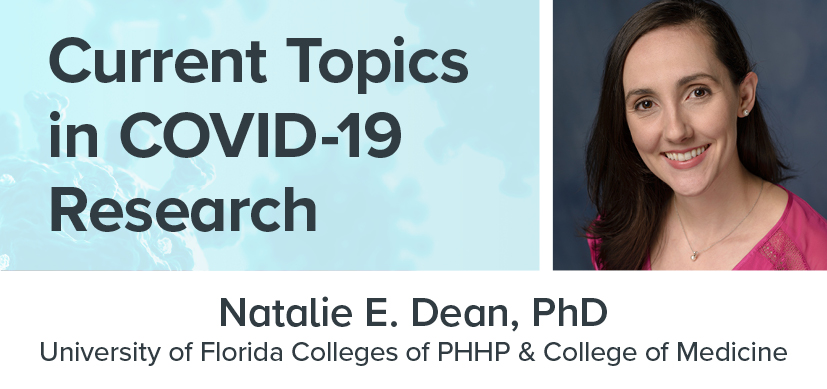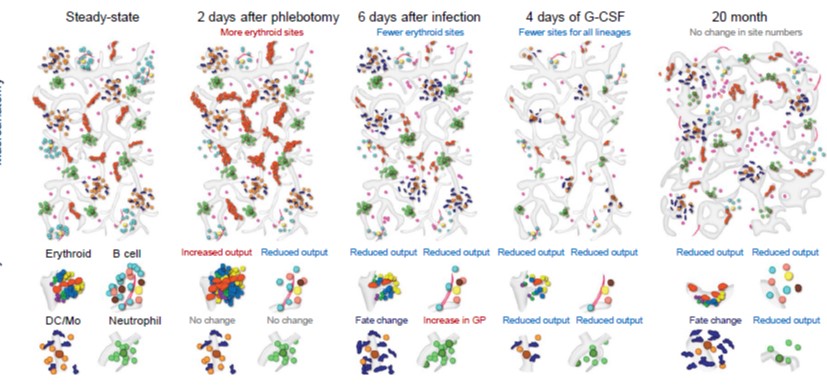Evaluating Vaccines for Emerging Infectious Diseases
Post Date: May 17, 2021 | Publish Date:

When outbreaks occur in remote communities, traditional vaccine efficacy trials may not be feasible. Dean suggests a ‘trial-in-a-box’ as one alternative strategy.
During the sixth installment of the Current Topics in COVID-19 Research Seminar Series on May 12, 2021, Natalie E. Dean, PhD, described several innovative strategies for evaluating investigational vaccines tailored to the epidemic context. (click here to watch the recording).
Dean is currently an Assistant Professor of Biostatistics at the University of Florida’s Colleges of PHHP and the College of Medicine, and will soon be transitioning to a new role at Emory University. As an expert in novel vaccine trial design and analysis, Dean specializes in infectious disease epidemiology and is a statistical consultant for the World Health Organization (WHO) where she has worked on evaluation of a coronavirus vaccine.
PLANNING FOR FUTURE PUBLIC HEALTH EMERGENCIES
Since 2016, Dean has been a part of the R&D Blueprint for Action to Prevent Epidemics, which is a WHO initiative that recognizes the importance of proactive and coordinated research and product development efforts in advance of public health emergencies.
“We need to be prepared with cross-cutting solutions,” she said.
Tasked with setting norms and standards for clinical trial designs, their work is focused around a number of different prioritized diseases that have been identified for their potential to cause public health emergencies and that lack adequate medical counter measures, such as MERS and SARS coronaviruses, Zika, Ebola, and Disease X.
COVID-19 VACCINES
Dean specifically called out the following in a 2019 perspective that she and her colleagues published about general recommendations for the design of efficacy trials during public health emergencies:
“The principal goal of a vaccine efficacy trial is to obtain efficacy and effectiveness data that can support broader use of a vaccine under a defined regulatory framework.”
This means that the level of evidence needs to match the intended use of the vaccine. For COVID-19, the intended use of the vaccine is for billions to get vaccinated, so the level of evidence has always needed to be extraordinarily high.
Many factors played into the rapid trials evaluation for COVID vaccines, including being able to manufacture at scale prior to regulatory approval, as this risk was assumed by governments. Instead of experiencing downtime between trials for information processing and decision planning, these vaccine manufacturing companies have been able to move full force and start planning subsequent steps before the prior step was completed.
“There’s been nothing sacrificed in terms of the level of evidence for efficacy and short-term safety,” she said. “The whole process has been accelerated.”
Dean noted that another component was the enormous, widespread scale of the COVID-19 epidemic and the high level of incidence.
“[The companies] were able to vastly exceed the number of endpoints they needed, but had to wait to get that median two months of follow up,” she revealed. “[This] really distinguishes it a lot from other types of vaccine trials, where usually the big limiting step is getting that full number of cases to evaluate efficacy.”
Dean also shared that COVID vaccines may increasingly need to be evaluated for non-inferiority rather than efficacy, given the authorization and pending approval of multiple vaccines.
DESIGNING VACCINE EFFICACY TRIALS FOR EMERGING PATHOGENS
Dean described that one of the key challenges for emerging infectious diseases is that the trial needs to be situated in an area where there is ongoing transmission in order to demonstrate vaccine efficacy.
“The trial needs to be in the right place at the right time,” she said.
However, when considering outbreak pathogens, she noted that it can be very hard to predict where outbreaks will occur. They can be spatially heterogeneous, unpredictable, clustered in various remote locations, and short-lived.
“We need a different strategy for how we’re going to evaluate these vaccines,” she suggested. “A lot of what I think about is ‘how do we make these trials work?’”
Dean went on to review several innovative strategies for evaluating vaccines for emerging infections.
RESPONSIVE DESIGNS
Dean mentioned that traditional efficacy trials are not always feasible in some endemic areas, but smaller, more flexible and responsive strategies are often more suitable.
She shared about her prior work on a Phase 3 Ebola vaccine trial that was conducted in Guinea during the West African epidemic and described the strategy of ring vaccination, which was used to eradicate smallpox in the 1970s.
“It’s a highly targeted vaccination strategy,” she said.
The basic idea is that each time a new case is observed from a surveillance system, contact tracing can be used to identify a secondary layer of contacts, which form a cluster and then becomes the unit in a randomized trial to evaluate the vaccine. Dean described this as a ‘trial-in-a-box,’ where mobile teams traveled to these remote communities and set up shop to assist with these efforts.
“[It] really showed what was possible, even in a highly resource limited setting in the context of a public health emergency,” she said.
Instead of using mobile teams, another responsive design idea is to create and enhance surveillance at a network of sites that have been pre-specified, but only move forward with enrolling and vaccinating people if there is some level of evidence that there’s transmission at that particular site.
“There’s some prework done, but you’re saving most of the effort for where you actually see transmission,” she said.
This strategy is best for fast acting vaccines, particularly for viruses that can cause large outbreaks, which Dean and her colleagues are exploring with modeling.
INTEGRATE MODELING
During the Zika epidemic, Dean and colleagues at Northeastern conducted modeling to explore the feasibility of a vaccine trial and help to prioritize where it should be located. In order to make these decisions, they used ensemble modeling to guide site prioritization or selection, assess expected duration or feasibility, and decide whether to add new sites.
“This is something that has been explored for COVID-19 and we’re still learning about the best way to operationalize some of these procedures,” she said.
CORE PROTOCOLS
Dean affirmed that waiting for large-scale outbreaks is not an effective strategy and all outbreaks represent an opportunity to advance research and development efforts.
“In the interim, you may miss a lot of these smaller outbreaks that add up to something quite substantial,” she noted.
She recommends using core protocols to design trials that can expand into new locations, with the basic overarching idea that one big trial is better than many smaller trials.
“The key recommendation is for everything to work together under one trial protocol,” she said. “The trial results would be released only following the advice of an independent data monitoring committee and not simply due to lack of recruitment.”
OBSERVATIONAL STUDIES
Dean mentioned that there may be situations where a phase 3 trial is not, for whatever reason, considered to be feasible and where modeling has shown that it may need to run for several decades. In this case, other lines of evidence would need to support the use of the vaccine, such as animal ROI or convincing immune response data based on other cohorts.
“You need to have some plan in place on how you’re going to evaluate the effectiveness of the vaccine in the real world,” she noted.
As possible solutions, she suggested observational studies using cohorts, case controls, and test negative methods. These address questions about subgroup specific effects and long-term effectiveness against infection, infectiousness, severe disease, hospitalization, death, and new variants.
Dean concluded her presentation by encouraging people to publish their protocols early on, so that others can take advantage of the lessons learned from more established groups about the best way to conduct these trials.
Watch a recording of the entire seminar.
NEXT UP IN THE CURRENT TOPICS IN COVID-19 RESEARCH SEMINAR SERIES
Paul Spearman, MD, Director of the Cincinnati Children’s Division of Infectious Diseases, and Robert W. Frenck Jr., MD, Director of the Cincinnati Children’s Vaccine Research Center, will present “COVID-19 vaccines revisited: uptake status and remaining questions.”
During their presentation, Spearman will discuss the rise of the new SARS-CoV-2 variants and what this means for domestic and global vaccine strategy as well as comment on second generation vaccines being developed. Frenck will provide an update on COVID-19 vaccine clinical trials currently in progress including moving vaccines into pediatric age groups.
Join this free virtual seminar at 2 pm (ET) June 9, 2021, via Zoom.






